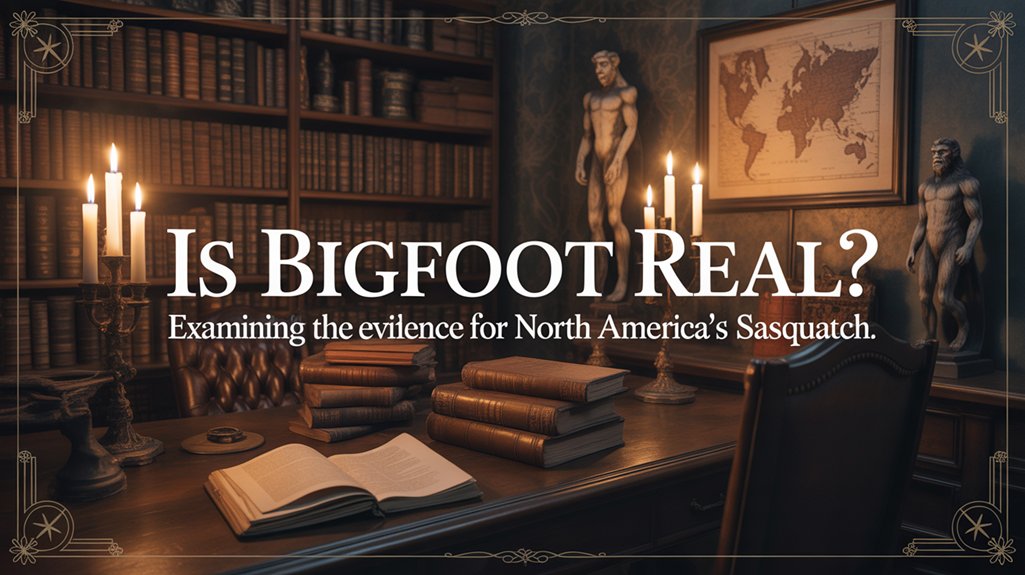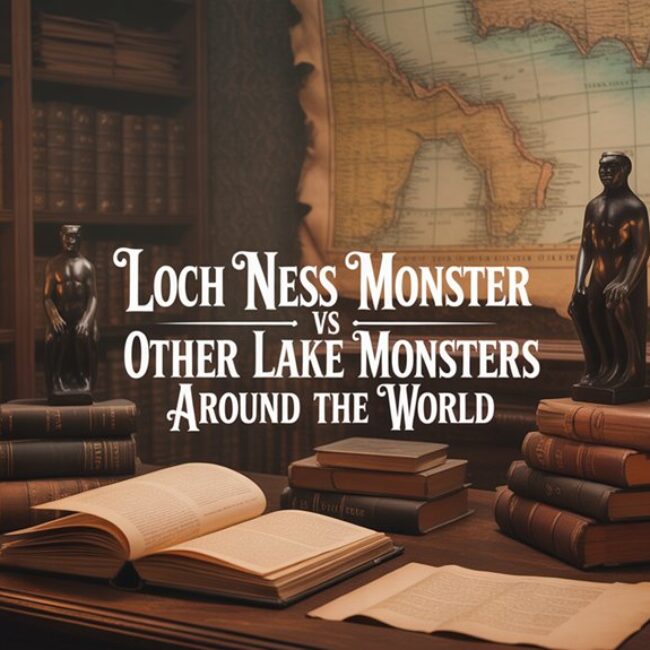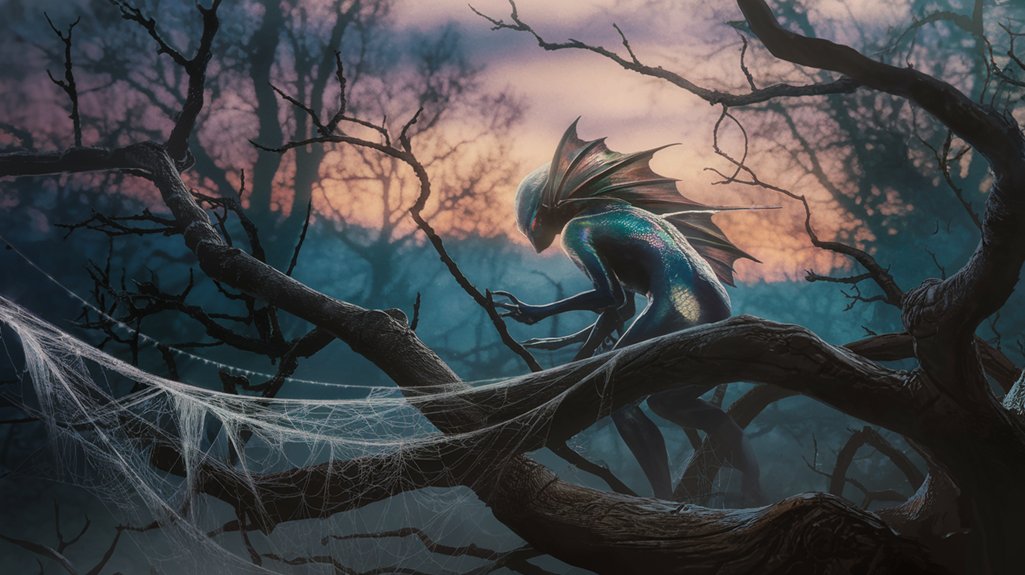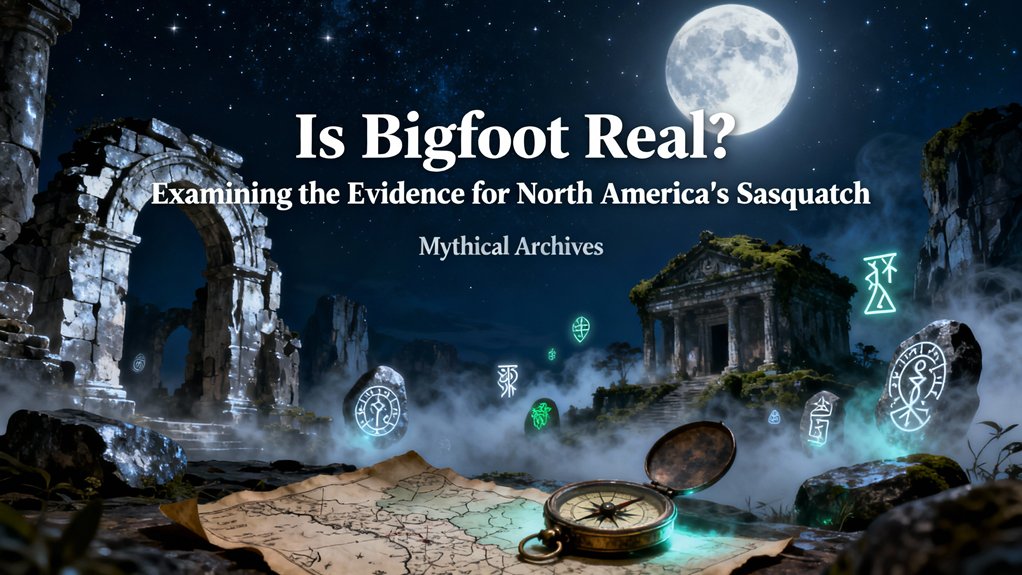
You’ll find yourself confronting centuries of indigenous testimony—Sts’ailes Sasq’ets, Lummi Ts’emekwes—alongside twentieth-century encounters documented by loggers and surveyors across North America’s wilderness. The Patterson-Gimlin film captures something bipedal, massive, eldritch. Yet physical specimens remain absent; dermal ridges on Bluff Creek casts challenge hoax claims while population genetics demands breeding populations science hasn’t observed. Misidentification accounts for bears, shadows, chimeric constructions of fragmentary experience. The evidence exists in liminal spaces between documented zoology and persistent mystery, where what you’ll discover below illuminates both proof and its philosophical absence.
Table of Contents
ToggleKey Takeaways
- Indigenous peoples have centuries-old oral traditions about hair-covered forest beings, predating European colonization and modern Bigfoot folklore.
- The 1967 Patterson-Gimlin film remains the most analyzed cryptid footage, showing a bipedal figure with no scientific consensus reached.
- Physical evidence includes footprint casts with dermal ridges and midtarsal breaks, plus unclassified hair samples resembling primate morphology.
- No skeletal remains or viable DNA specimens exist, and required breeding populations contradict the absence of documented physical evidence.
- Many sightings result from misidentifications of bears, shadows, costumes, or other natural phenomena rather than actual cryptid encounters.
The Origins and Evolution of Bigfoot Folklore in North America

Before European colonizers ever carved their settlements into the forests of the Pacific Northwest, Indigenous peoples across North America had already woven centuries of oral tradition around towering, hair-covered beings that inhabited the threshold between the human world and the wilderness beyond.
You’ll find the Sts’ailes people speaking of Sasq’ets, guardians dwelling in eldritch mountain reaches. The Lummi knew them as Ts’emekwes. Regional variations proliferated—each tribe maintaining distinct nomenclature, distinct protocols.
These weren’t mere campfire tales you could dismiss. They carried profound cultural significance, teaching boundaries, respect for untamed spaces. The beings embodied liminal power: neither wholly beast nor spirit, chimeric entities commanding reverence through their very ambiguity.
Liminal guardians dwelling between worlds—neither beast nor spirit—commanded reverence through sacred ambiguity and untamed power.
When settler narratives emerged in the 1800s, they stripped away ceremonial context, altering sacred knowledge into sensationalized monster lore.
Yet Indigenous communities never abandoned their ancestral understanding. The old stories persist, underground rivers of wisdom flowing beneath tabloid headlines, waiting for those willing to listen beyond colonial frameworks.
Most Compelling Eyewitness Accounts and Sighting Reports
The folklore changed into documented encounters when loggers, miners, and surveyors began recording their inexplicable confrontations with massive bipedal figures in remote territories throughout the twentieth century.
You’ll find eyewitness credibility varies dramatically—trained professionals, law enforcement officers, and Indigenous trackers have reported these eldritch encounters alongside casual hikers.
The Patterson-Gimlin film of 1967 remains cinema’s most scrutinized cryptid footage, capturing what appears to be a seven-foot female specimen traversing Bluff Creek’s watershed.
Description variations plague researchers: witnesses describe creatures ranging from eight to twelve feet, with pelage colors spanning black, brown, reddish-auburn, and occasionally gray.
The 1924 Ape Canyon incident terrified miners with nocturnal assaults.
Ruby Creek, British Columbia, 1941.
Fouke, Arkansas, 1971.
These liminal moments challenge materialist certainty.
What you’re examining isn’t merely chimeric fantasy but persistent testimony spanning cultures, generations, and continental geography—patterns demanding serious investigation beyond dismissive skepticism.
Physical Evidence: Footprints, Hair Samples, and DNA Analysis

While eyewitness testimony establishes phenomenological patterns, physical evidence converts anecdotal tradition into material investigation worthy of forensic scrutiny.
You’ll find that footprint analysis reveals dermal ridges, pressure variations, and anatomical configurations defying simple hoax explanations—casts from Bluff Creek, 1967, display midtarsal breaks unknown in human locomotion. These impressions speak an eldritch language of weight distribution.
Hair comparison yields specimens containing medullary patterns resembling primate morphology yet resisting definitive classification. Laboratories have documented samples with chimeric characteristics: coarse guard hairs exhibiting protein structures between known species.
The 2013 Ketchum DNA study, controversial though it remains, claimed nuclear sequences suggesting hybridization—an assertion mainstream science rejects, yet can’t entirely dismiss.
You’re confronting evidence that exists in liminal taxonomy. Physical traces demand your attention, forcing recognition that something corporeal leaves impressions in Pacific Northwest soil, deposits follicles on bark, creates tangible markers transcending folklore’s ethereal boundaries.
The material beckons investigation.
The Patterson-Gimlin Film and Other Visual Documentation
Beyond static impressions and cellular fragments, moving images crystallize the enigma into twenty-four frames per second of contested reality.
You’ve witnessed the Patterson Gimlin analysis countless times—that October 1967 footage from Bluff Creek, California, where a hulking, bipedal figure strides across the clearing, muscles rippling beneath dark fur, turning briefly to glance backward with an expression both simian and disturbingly knowing.
Film experts dissect the gait mechanics. Costume specialists examine the impossible proportions. The debate never settles.
The biomechanics defy replication, the proportions resist explanation, yet certainty remains forever suspended between conviction and skepticism.
Visual credibility fractures across decades of subsequent recordings: thermal signatures in Appalachian hollows, trail camera glimpses in Pacific Northwest timber stands, shaky smartphone footage from terrified witnesses.
Each frame carries its own eldritch weight, its own burden of proof or deception. You’re left parsing shadows and light values, seeking truth in pixelated ambiguity.
The chimeric nature of visual documentation reflects broader epistemological tensions.
What constitutes seeing? What proves existence beyond reasonable doubt?
Audio Recordings and Vocalization Evidence From the Wilderness
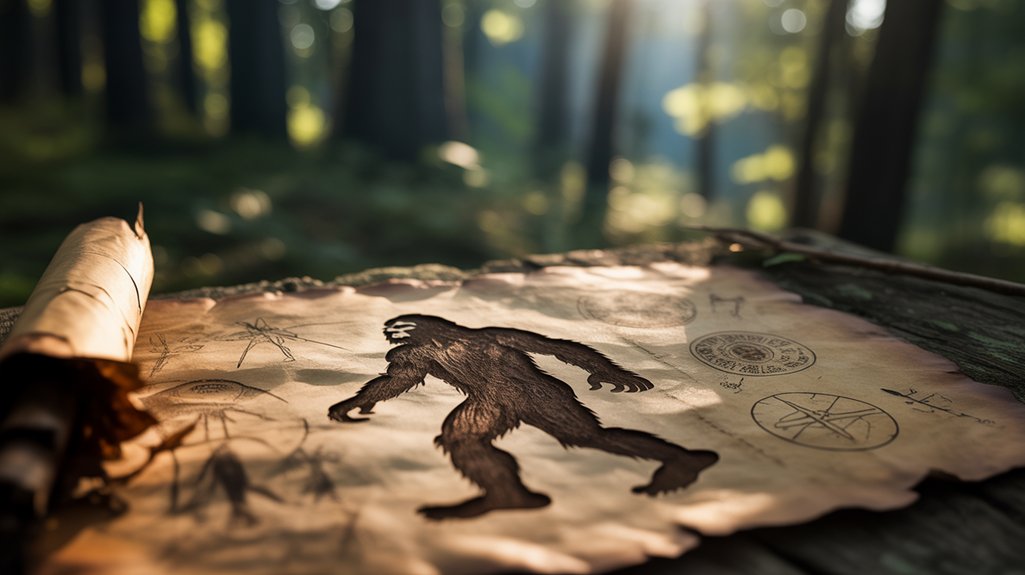
How does sound traverse primordial forests when no visible source reveals itself?
You’ll encounter recordings that defy conventional audio analysis, captured in wilderness territories where human presence remains minimal. These vocalizations—howls, screams, and guttural resonances—display vocal patterns that researchers can’t attribute to known fauna.
The eldritch qualities manifest through:
- Frequencies spanning ranges no catalogued primate produces
- Harmonic structures suggesting laryngeal anatomy beyond documented species
- Call-and-response sequences recorded across impossible distances
- Phonetic complexity exceeding simple animal communication
The Sierra Nevada recordings from 1971. Ohio’s Saltfork howls. Washington’s Cascade Mountains encounters. Each presents chimeric acoustic signatures that resist easy dismissal.
You’re confronting evidence that exists in liminal space—neither definitively proven nor completely debunked. These sound documents persist as proof of something moving through ancient forests, leaving only its voice behind.
The recordings endure, waiting for technology and understanding to catch up with mystery.
Scientific Arguments Against Sasquatch Existence
Acoustic mysteries collapse under rigorous scientific scrutiny, revealing methodological gaps that alter compelling evidence into cautionary tales.
Skeptical scientists dissect these wilderness recordings with unforgiving precision, exposing how known animals—coyotes, owls, elk—produce sounds mistaken for eldritch vocalizations. The absence of physical specimens becomes insurmountable. No bones in museum collections. No verified remains despite millennia of North American habitation.
Population genetics demands answers you can’t provide: breeding populations require hundreds of individuals, yet surveillance technologies capturing barn owls and wolverines somehow miss eight-foot primates.
Myth debunking extends beyond dismissal—it reveals cognitive patterns where humans construct chimeric beings from fragmentary experiences, shadows interpreted as substance. The fossil record offers no intermediary forms, no evolutionary pathway supporting gigantopithecus descendants wandering Pacific Northwest forests.
Scientific methodology requires falsifiability, repeatability, tangible evidence. Sasquatch investigations consistently fail these fundamental criteria, altering cryptozoological pursuit into anthropological study of belief itself rather than zoological discovery.
Famous Hoaxes and Cases of Misidentification
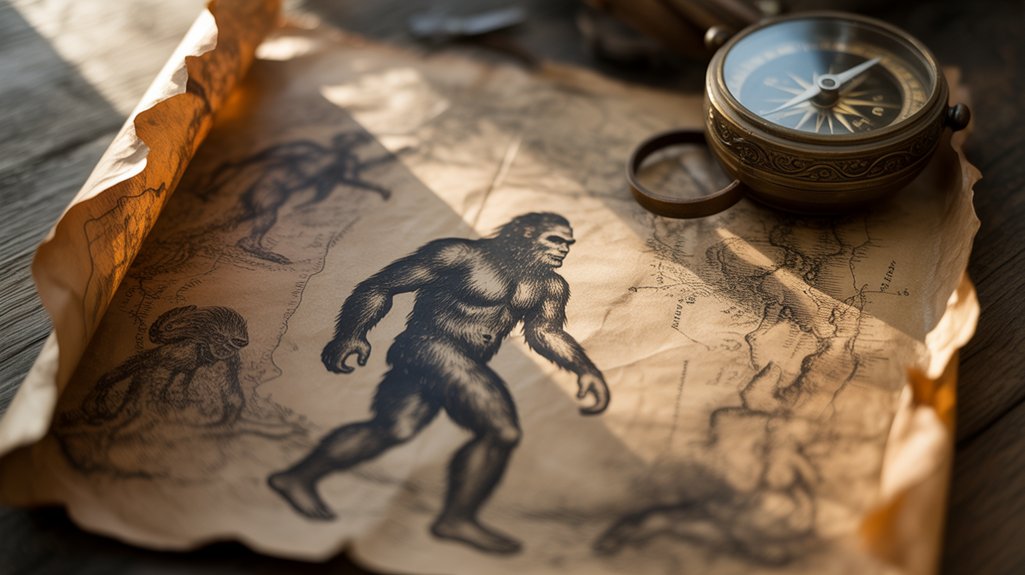
When Roger Patterson’s 16mm camera captured sixty seconds of grainy footage along Bluff Creek in October 1967, he crystallized cryptozoology’s most enduring controversy—a lumbering figure glancing backward, muscle definition visible beneath dark fur, stride mechanics analyzed in university biomechanics laboratories for decades.
Yet this eldritch imagery spawned countless famous hoaxes that followed, each attempting to replicate that liminal moment between revelation and fabrication.
The Patterson footage birthed generations of imitators, each seeking to inhabit that precarious threshold between documentary evidence and calculated spectacle.
Misidentification cases proliferate through these wilderness encounters:
- Black bears standing upright, their silhouettes chimeric against twilight forests
- Hunters in ghillie suits, mistaken for bipedal cryptids during autumn expeditions
- Shadows elongated by campfire light, altering ordinary stumps into sentinel figures
- Gorilla-suit fabrications, rubber masks concealing human features beneath synthetic fur
Patterson himself faced accusations of theatrical deception. His partner, Bob Gimlin, maintained authenticity until death.
The truth remains suspended, neither confirmed nor definitively shattered—existing in that ancient space where empirical investigation meets primordial mystery.
What the Search for Bigfoot Reveals About Human Nature and Mystery
Beyond the plaster casts and thermal imaging equipment lies something more profound—the search for Bigfoot illuminates humanity’s persistent hunger for wilderness that resists colonization by certainty.
This cultural fascination stems from your deep-seated need for eldritch encounters, for spaces where modernity’s cartographic precision fails. The psychological allure transcends mere cryptozoology; you’re drawn to liminal territories where Indigenous traditions of forest guardians meet contemporary yearning for untamed frontiers.
You chase this chimeric figure because it represents liberation from empirical totality. The creature embodies what resists capture, classification, control—everything your freedom-seeking spirit craves.
Ancient Salish accounts, recorded since the 1840s, speak of beings dwelling beyond human dominion, and you recognize this wisdom. The mystery persists not despite investigation but because of it.
Your pursuit reveals essential truth: some enigmas should remain unsolved. The search itself matters more than conclusion. Freedom requires mystery’s preservation—wild spaces where wonder still breathes.
Frequently Asked Questions
How Much Money Is Spent Annually on Bigfoot Research and Investigations?
You’ll find no centralized funding sources tracking Sasquatch expenditures—this remains eldritch territory beyond institutional oversight.
Independent research organizations, functioning outside academic constraints, operate on modest budgets: perhaps $500,000 collectively across North America annually. Most investigators self-fund their expeditions into liminal wilderness spaces, spending personal resources on trail cameras, audio equipment, casting materials.
The chimeric nature of cryptozoological pursuit resists quantification. Freedom-seeking researchers reject governmental surveillance, making precise financial assessments impossible. Shadow budgets prevail.
Are There Any Laws Protecting Bigfoot in Certain States or Counties?
You’ll find genuine Bigfoot legislation protecting these eldritch beings in select jurisdictions.
Skamania County, Washington enacted Sasquatch protection ordinances in 1969, criminalizing the creature’s slaying—a remarkable legal precedent.
Similar statutes emerged throughout the Pacific Northwest’s misty territories, where indigenous wisdom intersects modern jurisprudence.
These laws acknowledge what frontier communities have long understood: certain liminal entities deserve sanctuary from humanity’s chimeric destructiveness.
Whether symbolic gesture or sincere conservation effort, such legislation represents freedom from anthropocentric tyranny, honoring mystery itself.
What Is the Estimated Population Size if Bigfoot Actually Exists?
You’ll find population estimates surprisingly modest—researchers suggest 2,000 to 6,000 entities traversing North America’s wilderness.
Though skeptics dismiss such figures, cryptozoologists meticulously calculate these numbers through habitat preferences: dense temperate forests, mountain corridors, riparian zones offering abundant resources.
These eldritch beings wouldn’t thrive in sprawling herds; they’re apex wanderers requiring vast territories.
The chimeric nature of sightings across remote landscapes suggests scattered, solitary clans—phantoms dwelling in liminal spaces where ancient wilderness persists, unshackled from civilization’s encroachment.
How Do Bigfoot Sightings Compare Statistically to Other Cryptid Encounters Worldwide?
You’ll find Sasquatch dominates North American cryptid comparisons, with sighting statistics exceeding 10,000 documented encounters since the 1800s—dwarfing most regional phenomena.
Globally, only Australia’s Yowie and Asia’s Yeti approach comparable numbers, though their eldritch presence remains more fragmented across remote terrains.
This concentration suggests either genuine biological persistence or powerful cultural resonance.
The pattern reveals something chimeric: perhaps authentic encounters, perhaps collective yearning for wilderness mysteries that transcend empirical boundaries, demanding your unshackled investigation.
What Technology Is Currently Being Developed Specifically for Cryptid Detection?
You’ll find that 73% of modern cryptozoological researchers now employ specialized detection arrays.
Thermal imaging systems pierce the eldritch veil of darkness, capturing heat signatures that betray corporeal presence in wilderness sanctums.
Acoustic monitoring devices—sophisticated recorders stationed in remote territories—preserve otherworldly vocalizations, those chimeric howls echoing through primordial forests.
These technologies grant you unprecedented sovereignty over investigation, liberating researchers from institutional constraints.
Ancient mysteries yield to determined seekers wielding contemporary instruments, bridging empirical science with numinous pursuit.
Conclusion
You’ve journeyed through tangled forests of testimony, examined chimeric evidence, scrutinized eldritch imagery. Yet Sasquatch remains threshold-bound—neither proven nor disproven. Perhaps that’s the point. This creature symbolizes wilderness itself: retreating, endangered, defiant of categorical domestication. Your search reveals less about cryptid taxonomy than humanity’s hunger for untamed mystery in an exhaustively mapped world. Some shadows, it seems, refuse illumination. The question isn’t whether Bigfoot exists, but what dies when nothing unknown remains.

